
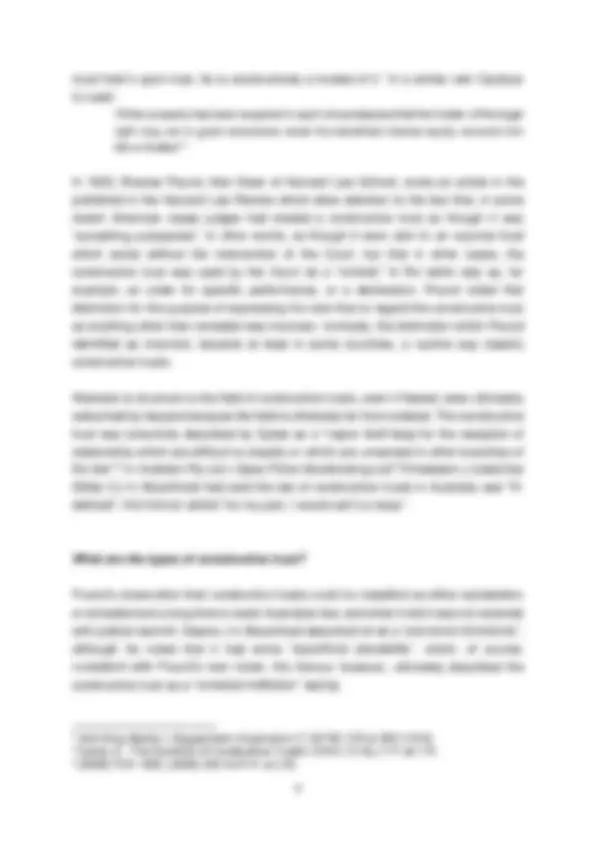
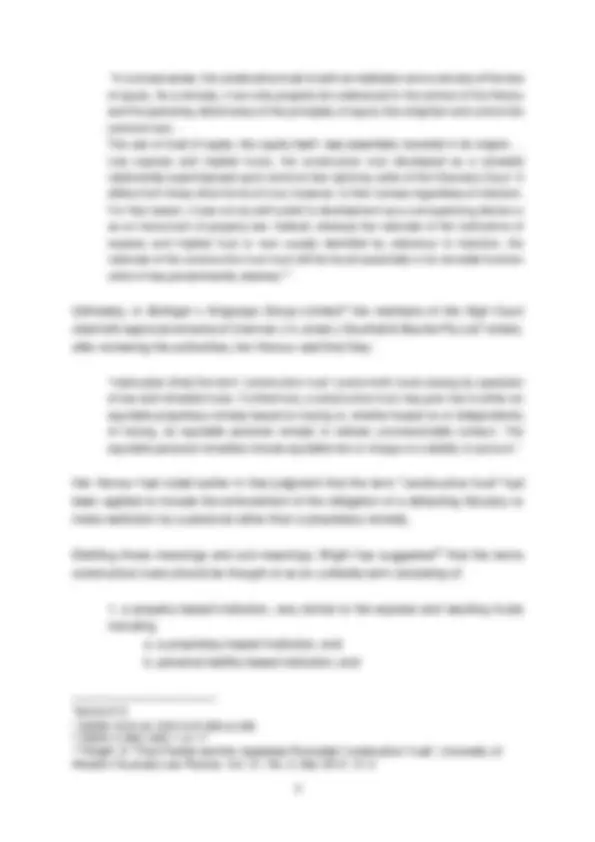
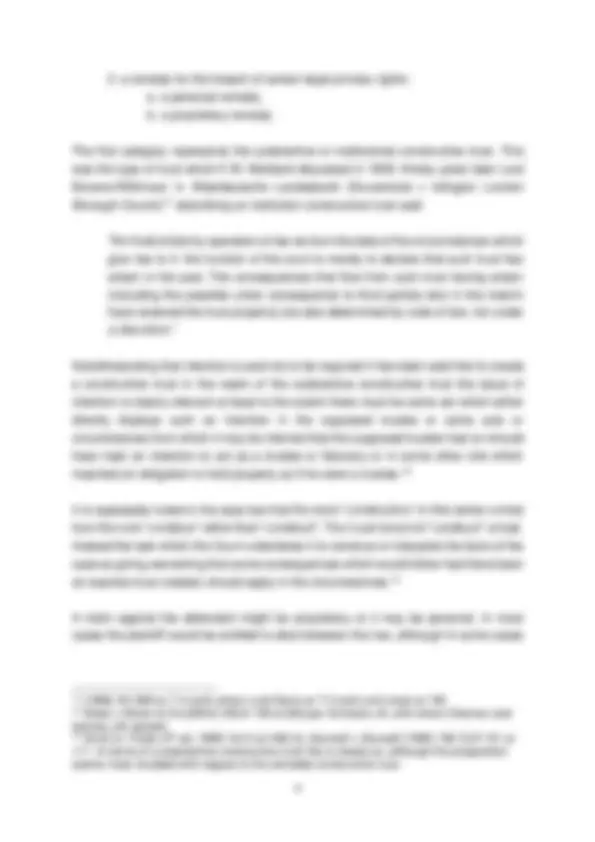
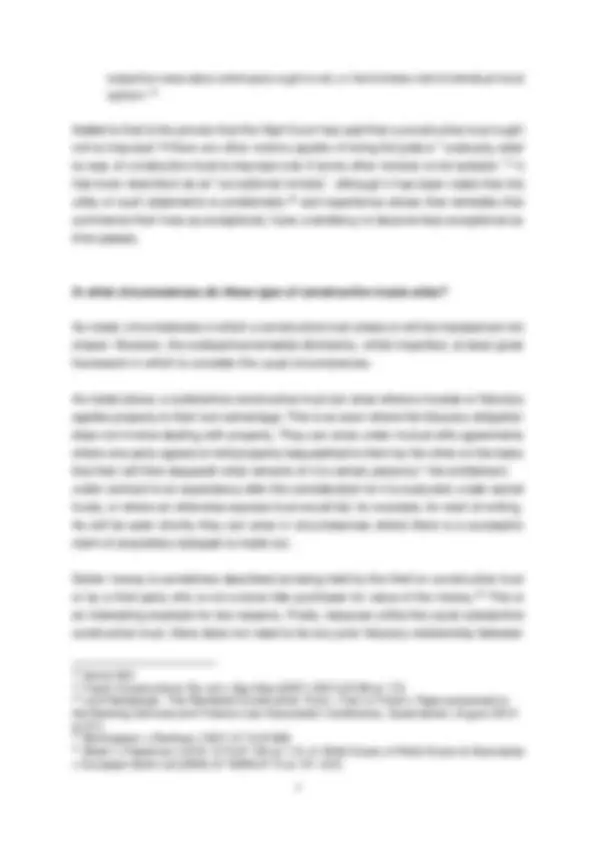

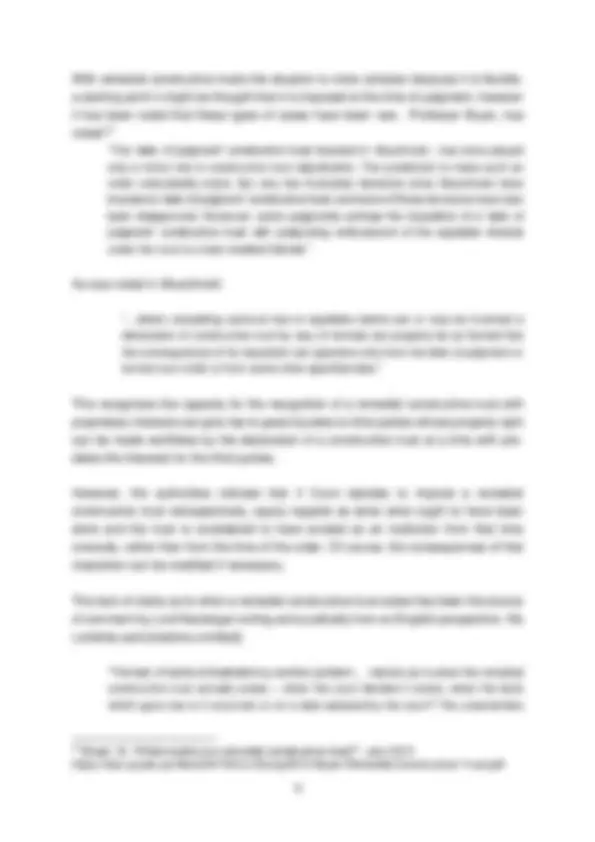
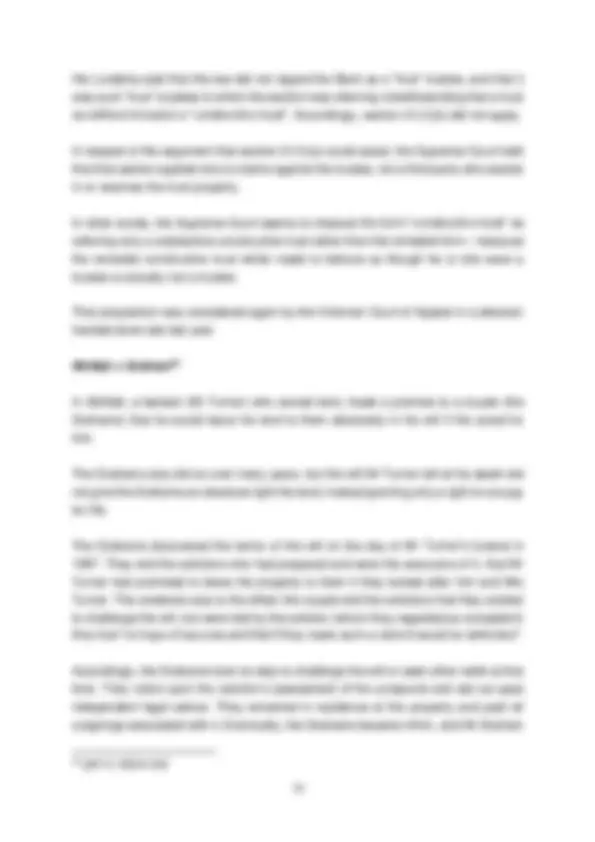
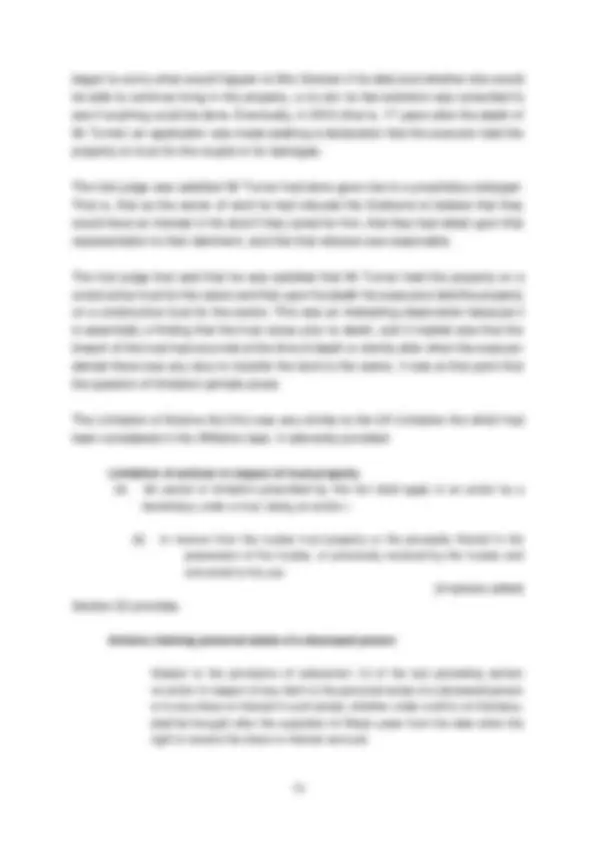
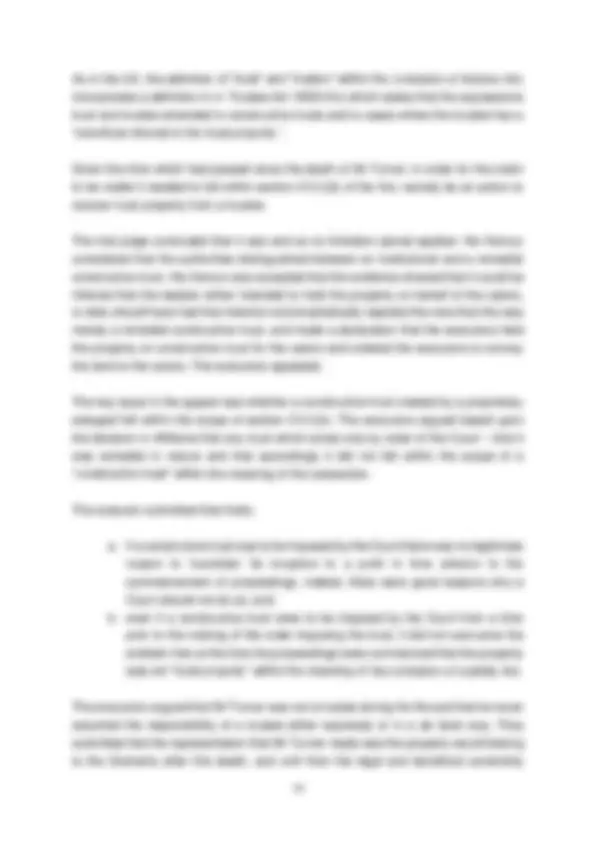
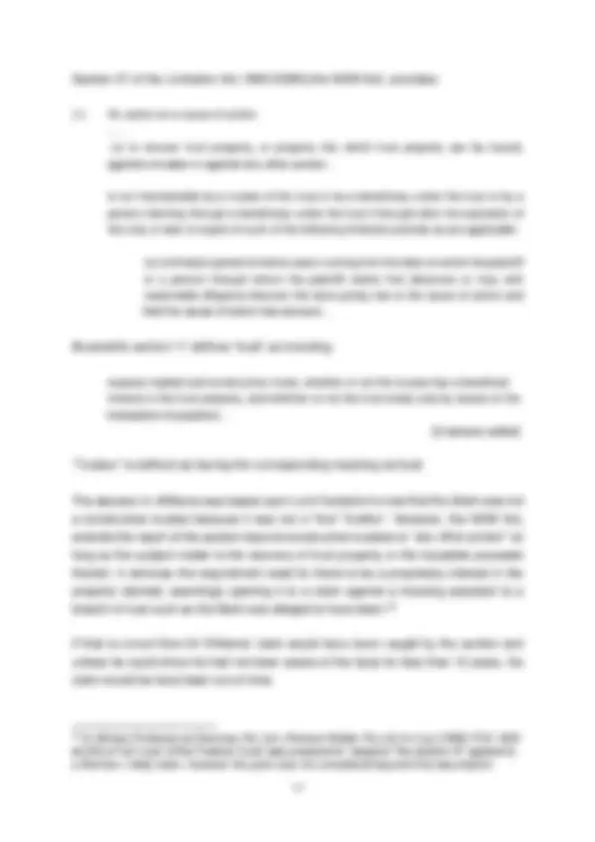
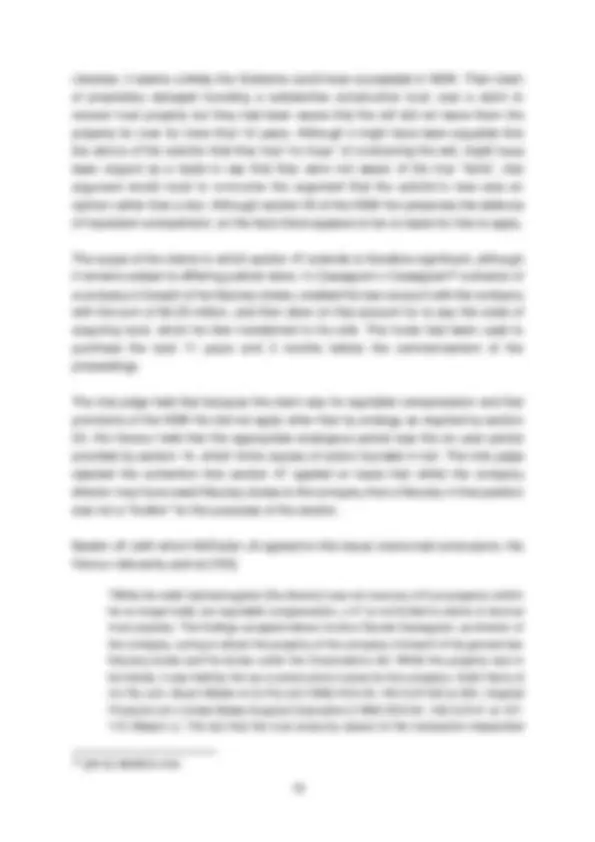
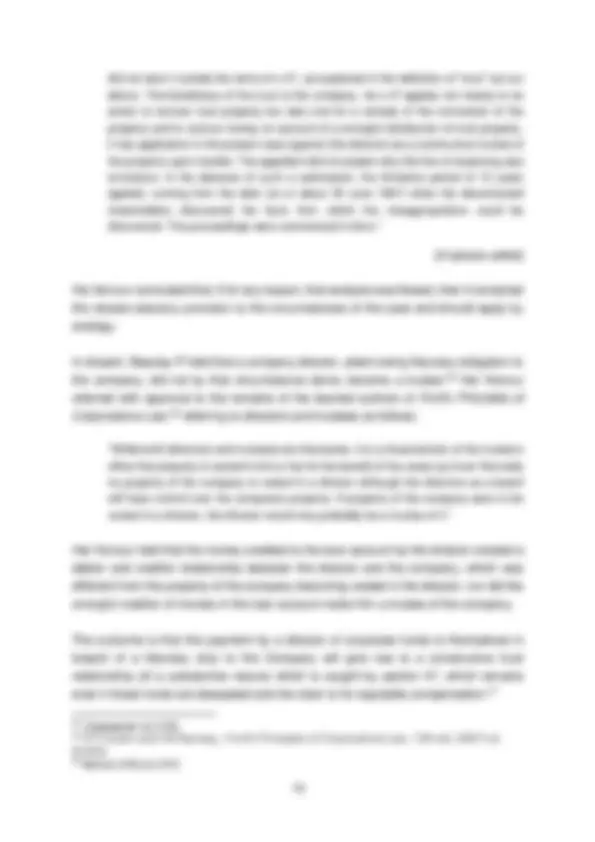
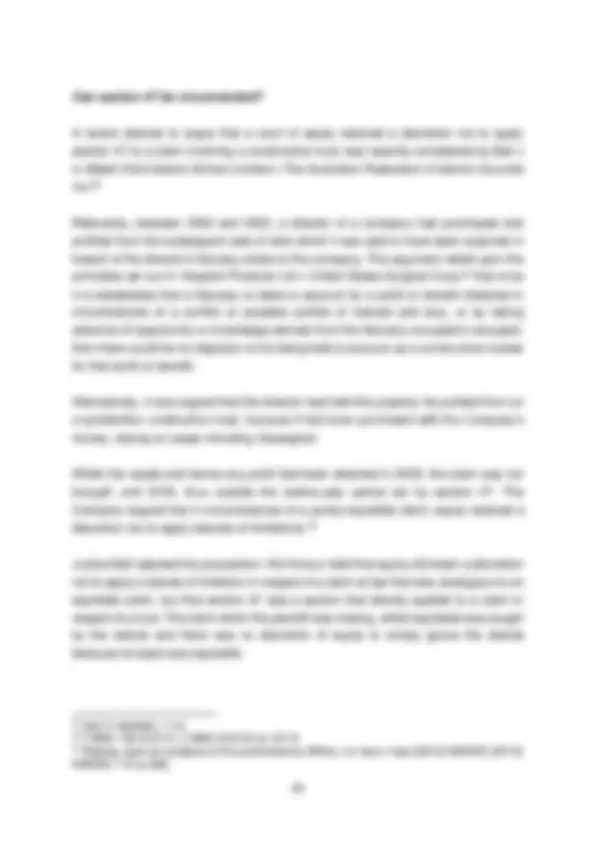
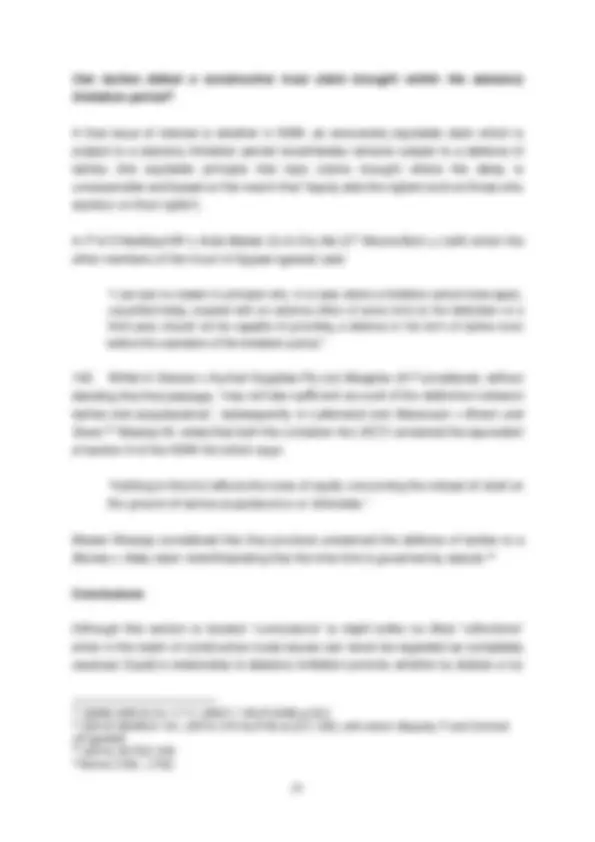
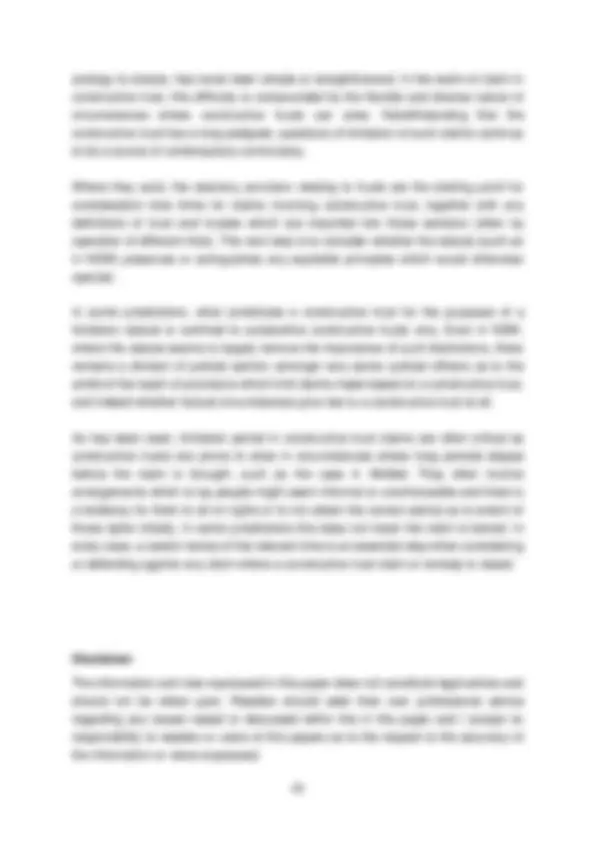


Study with the several resources on Docsity

Earn points by helping other students or get them with a premium plan


Prepare for your exams
Study with the several resources on Docsity

Earn points to download
Earn points by helping other students or get them with a premium plan
Community
Ask the community for help and clear up your study doubts
Discover the best universities in your country according to Docsity users
Free resources
Download our free guides on studying techniques, anxiety management strategies, and thesis advice from Docsity tutors
The constructive trust, a remedial institution in equity that is imposed regardless of actual or presumed agreement to prevent the retention or assertion of beneficial ownership of property that goes against equitable principles. the history and differences between substantive and remedial constructive trusts, as well as the limitations of constructive trust claims. The document also mentions some notable cases and legislation related to constructive trusts in Australia and the UK.
What you will learn
Typology: Lecture notes
1 / 23

This page cannot be seen from the preview
Don't miss anything!
















Liability limited by a scheme approved under Professional Standards Legislation.
What is a “constructive” trust?
The constructive trust has been referred to as one of the most difficult of all the equitable doctrines to understand, and consistent with this it is difficult to produce an all-embracing definition of what a constructive trust is. In Muschinski v Dodds Deane J, said:
“viewed in its modern context, the constructive trust can properly be described as a remedial institution which equity imposes regardless of actual or presumed agreement or intention (and subsequently protects) to preclude the retention or assertion of beneficial ownership of property to the extent that such retention would be contrary to equitable principle”.^1
His Honour’s approach was subsequently affirmed by all members of the High Court in Baumgartner v Baumgartner.^2
In a sense, the constructive trust is defined by its differences from the other types of trust. It is different from an express trust because it arises or is raised without reference to the intention of the parties and indeed is sometimes, contrary to the wishes of the constructive trustee. It does not need to comply with the statutory requirements of writing.
It is different from an implied or resulting trusts, because whereas in those cases the Court is looking for is the actual or presumed intentions of the parties, in the case of a constructive trust the inquiry goes further as to whether it would be a fraud or unconscientious for the constructive trustee to deny the trust.^3
The traditional English view of a constructive trust was explained by F.W. Maitland in his Lectures on Equity in 1906, as operating wherever a person clothed with a fiduciary character, gained some personal advantage by availing themselves that situation and so they became they became the trustee of the advantage obtained. Maitland opined “if by reason of his position [a] trustee acquires an advantage of a valuable kind, he
(^1) (1985) 160 CLR 583 at 614 (^2) (1987) 164 CLR 137 (^3) Heydon J, Leeming M, Jacobs’ Law of Trusts in Australia, 8 th (^) ed, LexisNexis 2016 at [13- 01]
“In a broad sense, the constructive trust is both an institution and a remedy of the law of equity. As a remedy, it can only properly be understood in the context of the history and the persisting distinctness of the principles of equity that enlighten and control the common law… The use or trust of equity, like equity itself, was essentially remedial in its origins … Like express and implied trusts, the constructive trust developed as a remedial relationship superimposed upon common law rights by order of the Chancery Court. It differs from those other forms of trust, however, in that it arises regardless of intention. For that reason, it was not as well suited to development as a conveyancing device or as an instrument of property law. Indeed, whereas the rationale of the institutions of express and implied trust is now usually identified by reference to intention, the rationale of the constructive trust must still be found essentially in its remedial function which it has predominantly retained.”^7
Ultimately, in Bofinger v Kingways Group Limited,^8 the members of the High Court cited with approval remarks of Crennan J in Jones v Southall & Bourke Pty Ltd ,^9 where, after reviewing the authorities, her Honour said that they:
“make plain [that] the term ‘constructive trust’ covers both trusts arising by operation of law and remedial trusts. Furthermore, a constructive trust may give rise to either an equitable proprietary remedy based on tracing or, whether based on or independently of tracing, an equitable personal remedy to redress unconscionable conduct. The equitable personal remedies include equitable lien or charge or a liability to account.”
Her Honour had noted earlier in that judgment that the term "constructive trust" had been applied to include the enforcement of the obligation of a defaulting fiduciary to make restitution by a personal rather than a proprietary remedy.
Distilling those meanings and sub-meanings, Wight has suggested^10 that the terms constructive trusts should be thought of as an umbrella term consisting of:
(^7) ibid at 613 (^8) [2009] HCA 44; 239 CLR 269 at [48] (^9) (2004) 3 ABC (NS) 1 at 17 (^10) Wright, D “Third Parties and the Australian Remedial Constructive Trust”, University of Western Australia Law Review, Vol. 37, No. 2, Mar 2014: 31- 5
The first category represents the substantive or institutional constructive trust. This was the type of trust which F.W. Maitland discussed in 1906. Ninety years later Lord Browne-Wilkinson in Westdeutsche Landesbank Girozentrale v Islington London Borough Council ,^11 describing an institution constructive trust said:
“the trust arises by operation of law as from the date of the circumstances which give rise to it: the function of the court is merely to declare that such trust has arisen in the past. The consequences that flow from such trust having arisen (including the possible unfair consequence to third parties who in the interim have received the trust property) are also determined by rules of law, not under a discretion.”
Notwithstanding that intention is said not to be required it has been said that to create a constructive trust in the realm of the substantive constructive trust the issue of intention is clearly relevant at least to the extent there must be some act which either directly displays such an intention in the supposed trustee or some acts or circumstances from which it may be inferred that the supposed trustee had (or should have had) an intention to act as a trustee or fiduciary or in some other role which imported an obligation to hold property as if he were a trustee.^12
It is repeatedly noted in the case law that the word “constructive” in this sense comes from the verb “construe” rather than “construct”. The Court does not “construct” a trust. Instead the task which the Court undertakes it to construe or interprets the facts of the case as giving warranting that some consequences which would follow had there been an express trust created, should apply in the circumstances.^13
A claim against the defendant might be proprietary or it may be personal. In most cases the plaintiff would be entitled to elect between the two, although in some cases
(^11) [1996] AC 669 at 714 (with whom Lord Glynn at 713 and Lord Lloyd at 738 (^12) Nolan v Nolan & Ors [2004] VSCA 109 at [80] per Ormiston JA, with whom Chernov and Eames JJA agreed. 13 Scott on Trusts (4th^ ed, 1989) Vol 5 at [462.4]; Giumelli v Giumelli (1999) 196 CLR 101 at
The remedial constructive trust can thus be used to in personam duty to account or to pay equitable compensation as though the person was a trustee.
English law has not embraced the notion of the remedial constructive trust.^15 However, in Nolan v Nolan,^16 Ormiston JA noted that English law contained a similar distinction, his Honour drew on the remarks of Millet LJ in Paragon Finance Plc v DB Thakerar & Co (a firm) as explaining the difference between a substantive and remedial constructive trust, even though his Lordship did not use those labels:
The first arise (at least in most cases) by reason of a lawful transaction which precedes any alleged breach, but the latter, if properly so described, come into existence only by reason of some act of fraud or other unlawful dealing. Although the first category are properly described as ‘constructive trusts’, the latter have been mis- described as such and, at the highest, those who have been subjected to remedial relief should be called ‘constructive trustees’ only for convenience’ sake to identify the kind of equitable relief against them. As Millett LJ expressed it:
In such a case he is traditionally though I think unfortunately, described as a constructive trustee and said to be ‘liable to account as constructive trustee’. Such a person is not in fact a trustee at all, even though he may be liable to account as if he were. He never assumes the position of a trustee, and if he receives the trust property at all it is adversely to the plaintiff by an unlawful transaction which is impugned by the plaintiff. In such a case the expressions ‘constructive trust’ and ‘constructive trustee’ are misleading, for there is no trust and usually no possibility of a proprietary remedy; they are ‘nothing more than a formula for equitable relief’: Selangor ... at 1582 ...
Notwithstanding its flexibility, the remedial constructive trust relief it not available on some free-wheeling basis or where its imposition is “fair”. The imposition of a remedial constructive trust must be warranted by established equitable principles or by the legitimate processes or legal reasoning rather than some idiosyncratic notions of fairness or justice.^17 The headnote to Muschinski notes:
“There is no place in Australian law for the notion of a constructive trust which is imposed by law whenever justice and good conscience require it. Proprietary rights all to be determined by principles of law and not by some mixture of judicial discretion,
(^15) Although as Collins, suggests, the approaches may not be as different as first thought: Collins, B. The remedial constructive trust ‘between a trust and a catch-phrase’, Trusts & Trustees, Vol. 20, No. 10, December 2014, pp. 1055– 1068. (^16) [2004] VSCA 109 at [61] (^17) Muschinski at 615 - 616
subjective views about which party ought to win, or the formless void of individual moral opinion.”^18
Added to that is the proviso that the High Court has said that a constructive trust ought not be imposed “if there are other orders capable of doing full justice” “ordinarily relief by way of constructive trust is imposed only if some other remedy is not suitable”.^19 It has been described as an “exceptional remedy”, although it has been noted that the utility of such statements is problematic,^20 and experience shows that remedies that commence their lives as exceptional, have a tendency to become less exceptional as time passes.
In what circumstances do these type of constructive trusts arise?
As noted, circumstances in which a constructive trust arises or will be imposed are not closed. However, the substantive/remedial dichotomy, whilst imperfect, at least gives framework in which to consider the usual circumstances.
As noted above, a substantive constructive trust can arise where a trustee or fiduciary applies property to their own advantage. This is so even where the fiduciary obligation does not involve dealing with property. They can arise under mutual wills agreements where one party agrees to hold property bequeathed to them by the other on the basis that their will then bequeath what remains of it to certain persons;^21 the entitlement under contract to an expectancy after the consideration for it is executed; under secret trusts; or where an otherwise express trust would fail, for example, for want of writing. As will be seen shortly they can arise in circumstances where there is a successful claim of proprietary estoppel is made out.
Stolen money is sometimes described as being held by the thief on constructive trust or by a third party who is not a bona fide purchaser for value of the money.^22 This is an interesting example for two reasons. Firstly, because unlike the usual substantive constructive trust, there does not need to be any prior fiduciary relationship between
(^18) ibid at 584 (^19) Farah Constructions Pty Ltd v Say-Dee ( 2007) 230 CLR 89 at 172. (^20) Lord Neuberger, The Remedial Constructive Trust – Fact or Fiction, Paper presented to the Banking Services and Finance Law Association Conference, Queenstown, August 2014 at [31] 21 Birmingham v Renfrew (1937) 57 CLR 666 (^22) Black v Freedman (1910) 12 CLR 105 at 110, cf Robb Evans of Robb Evans & Associates v European Bank Ltd (2004) 61 NSWLR 75 at 101 (CA)
With remedial constructive trusts the situation is more complex because it is flexible. a starting point it might be thought that it is imposed at the time of judgment, however it has been noted that these types of cases have been rare. Professor Bryan, has noted:^27 “The ‘date of judgment’ constructive trust imposed in Muschinski …has since played only a minor role in constructive trust adjudication. The jurisdiction to make such an order undoubtedly exists. But very few Australian decisions since Muschinski.. have imposed a ‘date of judgment’ constructive trust, and some of those decisions have later been disapproved. Moreover, some judgments confuse the imposition of a ‘date of judgment’ constructive trust with postponing enforcement of the equitable interest under the trust to a later-created interest.”
As was noted in Muschinski :
“…where competing common law or equitable claims are or may be involved a declaration of constructive trust by way of remedy can properly be so framed that the consequences of its imposition are operative only from the date of judgment or formal court order or from some other specified date.”
This recognizes the capacity for the recognition of a remedial constructive trust with proprietary interests can give rise to great injustice to third parties whose property right can be made worthless by the declaration of a constructive trust at a time with pre- dates the interests for the third parties.
However, the authorities indicate that if Court decides to impose a remedial constructive trust retrospectively, equity regards as done what ought to have been done and the trust is considered to have existed as an institution from that time onwards, rather than from the time of the order. Of course, the consequences of that imposition can be modified if necessary.
This lack of clarity as to when a remedial constructive trust arises has been the source of comment by Lord Neuberger writing extra judicially from an English perspective. His Lordship said [citations omitted]:
“The lack of clarity is illustrated by another problem…. namely as to when the remedial constructive trust actually arises – when the court decides it exists, when the facts which gave rise to it occurred, or on a date selected by the court? The uncertainties
(^27) Bryan, M, “What exactly is a remedial constructive trust?”, July 2013 https://law.uq.edu.au/files/23479/CLI-25July2013-Bryan-Remedial-Constructive-Trust.pdf
become painfully clear if one reads the judgment of the full Federal Court of Australia in Parsons v McBain , where they said that the cases displayed “a divergence of views as to when a [remedial] constructive trust … arises”, and then examined the cases. In an interesting analysis in a 2009 case, Ward J in the New South Wales Supreme Court rightly said, “As a general statement of principle, a constructive trust will be treated as coming into existence at the time of the conduct which gives rise to the trust” and the uncertainties and problems which arise if one departs from that elementary and clear principle are apparent when one reads the ensuing twenty paragraphs, and the analysis of statements from a number of cases, many of them in the High Court and already referred to. If it takes effect retrospectively, it is getting close to being an institutional constructive trust; if it takes effect on the date of the court order, that would be arbitrary in theory and often avoidable in practice. If it takes effect when the court decides, then some might say that the judges may all just as well close our courtrooms and head for the palm trees.”
Having said that I now turn to the issues of limitation of constructive trust claims, where, as will be seen, both the nature of a constructive trust and the time when it arises are important issues.
Williams v Central Bank of Nigeria^28
Williams is a 2014 decision of the UK Supreme Court. The plaintiff, Dr Williams, alleged that in 1986 he was induced into acting as a guarantor of what turned out to be a fraudulent transaction to import food into Nigeria. He paid over $6 million to an English solicitor to be held on trust, pending the release of funds in Nigeria. He alleged that the solicitor, in fraudulent breach of trust paid those funds to the defendant, a bank in Nigeria. He alleged that the bank was a knowing recipient of that funds; that knowingly assisted in the solicitor’s fraudulent scheme; or both. In other words, Dr Williams alleged that the bank was liable under both limbs of Barnes v Addy. Given the claim was commenced over 25 years later the transactions the Bank sought to strike out the claim as time barred.
Section 21 of the Limitation Act 1980 (UK) provided:
(1) No period of limitation prescribed by this Act shall apply to an action by a beneficiary under a trust, being an action — (a) in respect of any fraud or fraudulent breach of trust to which the trustee was a party or privy; or
(^28) [2014] UKSC 10
His Lordship said that the law did not regard the Bank as a "true" trustee, and that it was such "true" trustees to which the section was referring notwithstanding that a trust as defined included a “constructive trust”. Accordingly, section 21(1)(b) did not apply.
In respect of the argument that section 21(1)(a) could assist, the Supreme Court held that that section applied only to claims against the trustee, not a third party who assists in or receives the trust properly.
In other words, the Supreme Court seems to interpret the term “constructive trust” as referring only a substantive constructive trust rather than the remedial form – because the remedial constructive trust whilst made to behave as though he or she were a trustee is actually not a trustee.
That proposition was considered again by the Victorian Court of Appeal in a decision handed done late last year
McNab v Graham^30
In McNab, a testator (Mr Turner) who owned land, made a promise to a couple (the Grahams) that he would leave his land to them absolutely in his will if the cared for him.
The Grahams duly did so over many years, but the will Mr Turner left at his death did not give the Grahams an absolute right the land, instead granting only a right to occupy for life.
The Grahams discovered the terms of the will on the day of Mr Turner’s funeral in
Accordingly, the Grahams took no step to challenge the will or seek other relief at that time. They relied upon the solicitor’s assessment of the prospects and did not seek independent legal advice. They remained in residence at the property and paid all outgoings associated with it. Eventually, the Grahams became infirm, and Mr Graham
(^30) [2017] VSCA 352
began to worry what would happen to Mrs Graham if he died and whether she would be able to continue living in the property, a no-win no fee solicitors was consulted to see if anything could be done. Eventually, in 2015 (that is, 17 years after the death of Mr Turner) an application was made seeking a declaration that the executor held the property on trust for the couple or for damages.
The trial judge was satisfied Mr Turner had done gave rise to a proprietary estoppel. That is, that as the owner of land he had induced the Grahams to believe that they would have an interest in his land if they cared for him, that they had relied upon that representation to their detriment, and that that reliance was reasonable.
The trial judge that said that he was satisfied that Mr Turner held the property on a constructive trust for the carers and that upon his death his executors held the property on a constructive trust for the carers. This was an interesting observation because it is essentially a finding that the trust arose prior to death, and it implied also that the breach of the trust had occurred at the time of death or shortly after when the executor denied there was any duty to transfer the land to the carers. It was at that point that the question of limitation periods arose.
The Limitation of Actions Act (Vic) was very similar to the UK Limitation Act which had been considered in the Williams case. It relevantly provided:
Limitation of actions in respect of trust property (b) No period of limitation prescribed by this Act shall apply to an action by a beneficiary under a trust, being an action—
(b) to recover from the trustee trust property or the proceeds thereof in the possession of the trustee, or previously received by the trustee and converted to his use. [Emphasis added] Section 22 provides:
Actions claiming personal estate of a deceased person
Subject to the provisions of subsection (1 ) of the last preceding section no action in respect of any claim to the personal estate of a deceased person or to any share or interest in such estate, whether under a will or on intestacy, shall be brought after the expiration of fifteen years from the date when the right to receive the share or interest accrued.
remained with him. They submitted that this was not a case where the testator had assumed the status of a trustee but was at best a case where the testator had exposed the estate to an equitable remedy by participation in the unlawful misapplication of trust assets.
On that argument, neither the testator nor the executor was a trustee at any time prior to the making of the orders. Since section 21(b), on the authority of Williams the references to “trusts” and “trustees” did not apply to remedial constructive trustees, the claim was brought out of time.
The Court of Appeal unanimously rejected that proposition. The Court held that by making a representation that the Grahams would own the land upon which they relied, he had given them a proprietary interest in the land. The testator either intended or should have intended that the land was held on trust for the Grahams to take ownership upon Mr Turner’s death. That meant that the trust was substantive or institutional and that is arose without the making of any order.
The Court of Appeal held that notwithstanding that the UK Supreme Court had found that a constructive trustee who is a wrongdoer in the sense of a Barnes v Addy accessory would not fall within the limits of the term “trustee” within the section, those circumstances were very different from this case. In the case of a Barnes v Addy defendant, they are a wrongdoer who is never a “true” trustee in the relevant sense. The situation here was different because by his actions Mr Turner did or should have intended to hold the property on trust for the Grahams. For the purposes of that section a substantive constructive trustee can be regarded to use Lord Sumption’s words as a “true trustee” whereas a remedial constructive trustee cannot.
As to the executor’s point that the backdating of the date of the constructive trust to around the date of Mr Turner’s death, the Court of Appeal held that the declaration of the existence of the constructive trust was not a matter of “backdating” the trust arbitrarily or to defeat a limitation period. It was a matter of the Court declaring the appropriate date on which that which ought to have been done is regarded as having been done. Once so declared, the effect of the maxim that equity “regards as done that which ought to have been done” has the effect that so far as the Court was concerned, it was done at that time.
For completeness it should be noted that in an earlier case the Victorian Court of Appeal had (in obiter) indicated considerable skepticism that the term “constructive trust” within section 21 of the Limitation of Actions Act would include a remedial
constructive trustee.^31 However, in neither case was the constructive trust being considered was substantive. Given the High Court’s endorsement of the proposition in Bofinger of the proposition that a constructive trust includes both remedial and constructive trust, it may be that the question of whether a provision such as section 21(1)(b) can apply to a remedial constructive trustee is not completely closed in Australia.
Finally, in decision handed down last month, in Burnden Holdings (UK) Ltd v Fielding & Anor^32 and Another recent UK Supreme Court determined where, by an unlawful, but non-fraudulent transaction, a director of a company Defendants converts the company property to his or own our or procures of participates in the unlawful distribution of it to a third party, then the action to recover that property by the company or, in this case, its liquidator fell within section 21(1)(b) and so was not subject to any time bar.
The Supreme Court held that whilst section 21 is primarily aimed at express trustees it was applicable to company directors by analogy, and that under the typical constitution of an English company the directors are regarded as being in possession of trust property (being company property) from the outset. Thus, where a director’s misappropriation of the company’s property amounts to a conversion of it to their own use (whether directly or through a corporate entity), then an action will lie for the recovery of trust property within the meaning of section 21(1)(b) and, in England, and presumably Victoria, not time barred. Whilst the Court referred to the application as being by “analogy” to an express trust, another way of viewing the facts is that by misappropriating the company’s property to their own use, the directors became constructive trustees in the substantive sense.
What might the outcomes have been in NSW?
An interesting question arises as to what the outcomes in Williams and McNab would have been in NSW. In my view both claims would likely have failed.
The Limitation Act in NSW bears some similarities to the UK and Victorian Act but there are also important differences.
(^31) Nolan v Nolan & Ors [2004] VSCA 109 at [61] – [67]. (^32) [2018] UKSC 14
Likewise, it seems unlikely the Grahams could have succeeded in NSW. Their claim of proprietary estoppel founding a substantive constructive trust, was a claim to recover trust property but they had been aware that the will did not leave them the property for over for more than 12 years. Although it might have been arguable that the advice of the solicitor that they had “no hope” of overturning the will, might have been argued as a basis to say that they were not aware of the true “facts”, that argument would need to overcome the argument that the solicitor’s view was an opinion rather than a fact. Although section 55 of the NSW Act preserves the defence of fraudulent concealment, on the facts there appears to be no basis for that to apply.
The scope of the claims to which section 47 extends is therefore significant, although it remains subject to differing judicial views. In Cassegrain v Cassegrain^34 a director of a company in breach of his fiduciary duties, credited his loan account with the company with the sum of $4.25 million, and then drew on that account for to pay the costs of acquiring land, which he then transferred to his wife. The funds had been used to purchase the land 11 years and 3 months before the commencement of the proceedings.
The trial judge held that because the claim was for equitable compensation and that provisions of the NSW Act did not apply other than by analogy as required by section
Basten JA (with whom McFarlan JA agreed on this issue) overturned conclusions. His Honour relevantly said at [193]:
“While the relief claimed against [the director] was not recovery of trust property (which he no longer held), but equitable compensation , s 47 is not limited to claims to recover trust property. The findings accepted above involve Claude Cassegrain, as director of the company, acting to obtain the property of the company in breach of his general law fiduciary duties and his duties under the Corporations Act. Whilst the property was in his hands, it was held by him as a constructive trustee for the company: Keith Henry & Co Pty Ltd v Stuart Walker & Co Pty Ltd [1958] HCA 33; 100 CLR 342 at 350; Hospital Products Ltd v United States Surgical Corporation [1984] HCA 64; 156 CLR 41 at 107- 110 (Mason J). The fact that the trust arose by reason of the transaction impeached
(^34) [2013] NSWCA 454.
did not take it outside the terms of s 47, as explained in the definition of "trust" set out above. The beneficiary of the trust is the company. As s 47 applies not merely to an action to recover trust property but also one for a remedy of the conversion of the property and to recover money on account of a wrongful distribution of trust property, it has application in the present case against [the director] as a constructive trustee of the property upon transfer. The appellant did not explain why this line of reasoning was erroneous: in the absence of such a submission, the limitation period of 12 years applied, running from the date (on or about 30 June 1997) when the discontented shareholders discovered the facts from which the misappropriation could be discovered. The proceedings were commenced in time.”
[Emphasis added]
His Honour concluded that, if for any reason, that analysis was flawed, then it remained the closest statutory provision to the circumstances of the case and should apply by analogy.
In dissent, Beazley P held that a company director, albeit owing fiduciary obligation to the company, did not by that circumstance alone, become a trustee.^35 Her Honour referred with approval to the remarks of the learned authors of Ford’s Principles of Corporations Law,^36 referring to directors and trustees as follows:
"While both [directors and trustees] are fiduciaries, it is a characteristic of the trustee's office that property is vested in him or her for the benefit of the cestui qui trust. Normally no property of the company is vested in a director although the directors as a board will have control over the company's property. If property of the company were to be vested in a director, the director would very probably be a trustee of it."
Her Honour held that the money credited to the loan account by the director created a debtor and creditor relationship between the director and the company, which was different from the property of the company becoming vested in the director, nor did the wrongful creditor of monies in the loan account make him a trustee of the company.
The outcome is that the payment by a director of corporate funds to themselves in breach of a fiduciary duty to the Company will give rise to a constructive trust relationship (of a substantive nature) which is caught by section 47, which remains even if those funds are dissipated and the claim is for equitable compensation.^37
(^35) Cassegrain at [133] (^36) R P Austin and I M Ramsey, Ford's Principles of Corporations Law , 13th ed, (2007) at [8.050] (^37) ibid at [135] to [137]